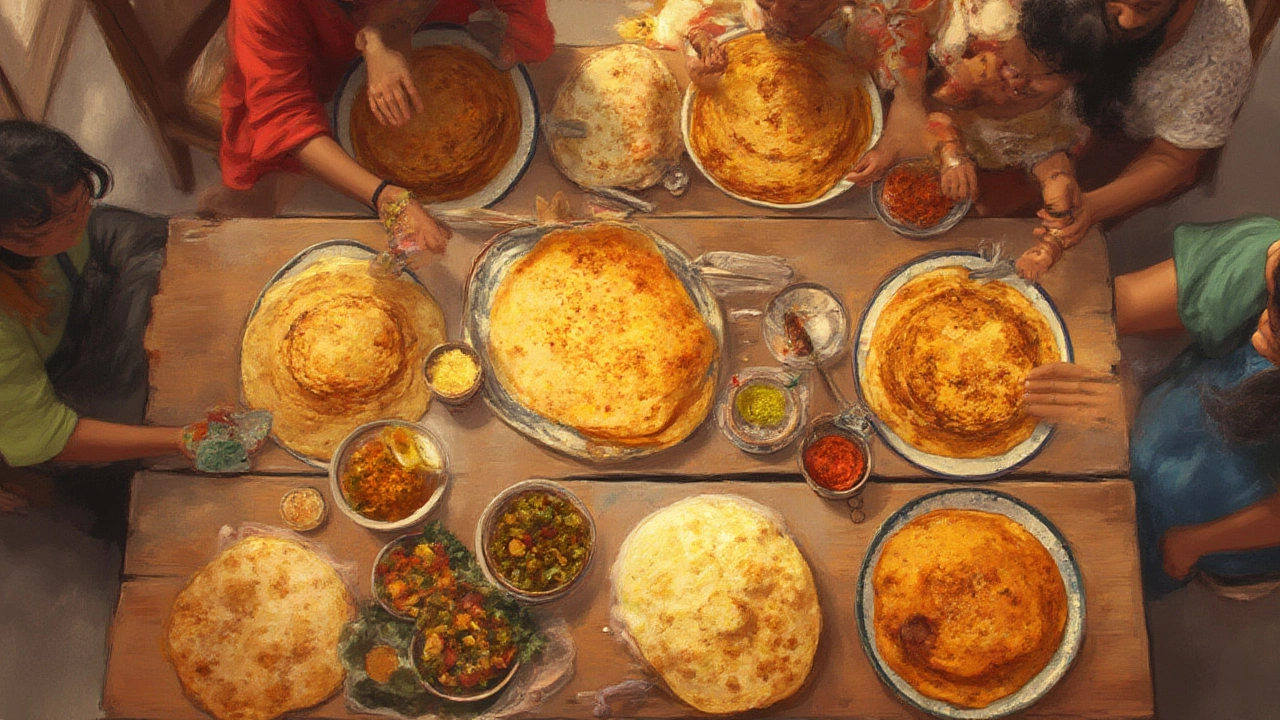Ever stood in the kitchen, all pumped to make a fresh dosa batter, only to realize you’re out of – you guessed it – fenugreek? The same tiny seeds everyone claims are a non-negotiable for a proper dosa. It can feel like the end of the road. But before you give up and reach for that boring old bread, let’s figure out if dosa is even possible without fenugreek, why it matters, and what actually works if you skip it.
Why Fenugreek Is Traditionally Added to Dosa Batter
Let’s get one thing straight: fenugreek (or "methi" seeds, if you like the local touch) is not in dosa batter just to make things complicated for home cooks. Traditionally, South Indian families use fenugreek because it helps kick-start fermentation—yeah, that magical process that gives dosas their unbeatable tang and crispiness. When soaked and ground with rice and urad dal, it lends a subtle, toasty bitterness, but more importantly, its natural mucilage (think: thick, sticky texture) helps the batter turn smooth and gives the final dosa that classic lacy finish.
But get this. There’s no ancient hard rule that dosa can’t be made without fenugreek. Dosa is old—referenced as far back as the 1st century AD in Tamil literature. Yet, in many South Indian homes, especially when someone’s allergic or just ran out, dosa happens anyway. Plus, in restaurants, commercial settings, or even busy families, skipping fenugreek isn’t exactly new. If you check Reddit threads or ask an elderly neighbor, you’ll find plenty who skip it for one reason or another. Here’s the best part: you do have options!
What Really Happens When You Leave Out Fenugreek
It helps to understand what you actually lose (and what you don’t) minus fenugreek. Drop it, and your batter may ferment a bit slower since fenugreek’s special sugars boost the growth of lactobacillus—the bacteria behind that tang and fluff. Your dosas may also lack some of that signature aroma and be slightly less crispy. But the sky won’t fall. Your dosa can still be amazing, with a bit of tweaking. Sometimes people even prefer the taste without fenugreek, since it can turn slightly bitter if used too much.
Curious about the science? Here’s a quick look at how fenugreek affects dosa batter as compared to "no-fenugreek" versions, based on at-home and food science tests:
| Quality | With Fenugreek | Without Fenugreek |
|---|---|---|
| Fermentation Speed | 12–16 hours (warm) | 14–20 hours (may need longer) |
| Texture | Smooth & lacy, slightly sticky | Can still be soft, but may need extra grinding or water |
| Flavor | Mild, slightly bittersweet | More rice-forward, clean, no bitterness |
| Crispiness | High, when spread thin | Still good, but can be a tad softer |
So yes, with careful soaking, grinding, and a little patience, a dosa that stands tall without fenugreek is absolutely possible.
Smart Substitutes and Creative Hacks When You’re Out of Fenugreek
No fenugreek? No problem. Some of the best dosas are born out of what’s in the pantry. If you’re after that same sticky-smooth batter or extra fermentation boost, try these options:
- Chana dal or toor dal: Swap a tablespoon of urad dal with either. Both give a yellowish hue, but help fermentation get going. Don’t go overboard, though—two tablespoons max for 2 cups rice.
- Poha (flattened rice): Soak and add a handful when grinding your batter. It’ll make the dosa fluffy and light, giving some softness fenugreek usually provides.
- A dash of cooked rice: About two tablespoons of cooked rice blitzed into your batter will up the stickiness and improve lacing.
- Yogurt: Mix in a tablespoon of plain yogurt after grinding. It won’t boost crispiness, but boy will it help with fermentation and aroma.
- Some specific "dosa mixes"—the grocery kind—skip fenugreek entirely and still yield passable dosas in a pinch.
To get more technical, the main reason these work is because all add natural sugars or help absorb more water, which feeds the right kinds of microbes to make your batter rise. Stack them together for best results (for example, poha plus cooked rice plus a dash of yogurt) if you really want to mimic that fenugreek magic.

How to Ferment Dosa Batter Without Fenugreek – Tips and Tricks That Work
Batter not rising? Dosa turning gummy? It’s mostly a matter of temperature and time. Without fenugreek, you need to be smarter about these:
- Use warm water (not hot!) to soak rice and dal. About 30–35°C is ideal for kickstarting fermentation.
- Grind to silky smoothness. If you’re not grinding in a wet grinder (lucky you if you are), go slowly in the blender, adding water little by little. Look for a "clingy" batter, not runny.
- Ferment somewhere warm. Near your oven light, on top of the fridge, or even inside the microwave (turned off, with a mug of steaming water inside to keep humidity) works wonders.
- Allow extra time. If it usually takes 12 hours for your batter to double, plan for up to 18 hours. If it’s still sluggish, stir in a pinch of sugar after 12 hours and wait a touch longer.
- Don’t add salt before fermenting. Wait until batter is ready to cook, then salt to taste—this prevents slow or stunted fermentation, especially important when skipping fenugreek.
- If all else fails, dosa without fenugreek works best when made a little thicker—call it an "uthappam"—so don’t stress if the first few are a bit soft. They’ll taste lovely with chutney or a spicy podi.
Pay attention to how the batter smells: a pleasant, sour scent means it’s ready. Too much sourness means you waited a little too long, but the first dosa is always a test run, so just adjust the heat.
The Surprising Pros and Cons of Fenugreek-Free Dosa
Here’s something fun: dosa without fenugreek isn’t just a compromise—it’s a legit variant. Some people actually prefer it because fenugreek, while healthy (full of fiber and minerals), can trigger allergies or upset digestion in sensitive folks. Some diabetics are told by doctors to avoid large quantities due to possible blood sugar interactions.
You also get a lighter, not-so-bitter flavor. Kids or first-timers may like dosas minus the fenugreek’s strong notes. Plus, dosa batter without fenugreek can taste fresher and pairs nicely with a mild coconut chutney. But don’t just take my word for it—popular food writers like Chitra Agrawal and culinary researcher Srividya Narayanaswamy have published versions that use either very little fenugreek or none at all, focusing on local grains or souring with yogurt.
Here’s another plus: playing with your batter (adding poha, chana dal, even a touch of yeast if you’re really desperate) keeps you flexible. Adjusting for taste, texture, or dietary needs becomes second nature, and everyone loves a dosa made just how they like it. On the downside, you’ll miss out on the exact nutty aroma and robust crispiness that a heavy fenugreek hand brings. But trade-offs can be delicious, right?
Step-By-Step: My Dosa Recipe Without Fenugreek
Ready to try it? I’ve gotten rave reviews for this formula, tweaked over weekends and tested in the summer humidity of Mumbai and the cold, dry kitchens of Toronto. This version guarantees a golden, crisp, and flavorful dosa—without the famous seeds.
- Take 2 cups short-grain rice (sona masuri works great) and 1/2 cup whole urad dal. If you like, toss in a tablespoon each of chana dal and thick poha.
- Rinse everything together three times, then soak with just enough warm water to cover for at least 6 hours (8 is fine too).
- Drain, then grind everything together in a wet grinder (or a strong blender), adding water as needed, until smooth and pourable but NOT watery. Add 2 tablespoons cooked rice if you have it.
- Transfer to a large bowl, cover with a loose lid or plate (never airtight), and park somewhere warm (see earlier tips) for up to 18 hours.
- Once doubled and airy with a slight tang, stir batter gently, add salt, and mix again. If it’s too thick, a splash of water does the trick.
- Preheat your skillet or nonstick pan, oil it lightly, then drop a small ladle of batter in the center. Spiral outward using the back of the ladle, spread it thin, drizzle oil around the edges, and cook until the bottom is golden brown. Flip if you prefer both sides crisp.
- Serve piping hot with chutney—preferably coconut, but even a spicy tomato one works!
This recipe will give 10–12 dosas, enough for breakfast or brunch for four hungry people. If you want to freeze the batter, go ahead. Just note that batter thickens a little after refrigeration, so add a splash of water before cooking your next round.
The fuller truth is that dosa, like all great comfort food, is less about rules and more about rhythm. Missing fenugreek? Play with substitutions. Be patient with fermentation. Listen for the sizzle as that first dosa hits the tava, and don’t panic if the first attempt isn’t perfect. The real joy comes from making it your way—and sharing the results with someone you love, no matter what’s in the batter.
